Ads for healthcare live by rules other industries never have to think about. You must respect strict regulations, protect vulnerable patients, and stay medically accurate—while still generating growth.
Quick Answer: The Best Healthcare Advertising Solutions Include:
U.S. healthcare digital ad spend hit $13.82 billion in 2023. More importantly, 70 % of patients start their journey with an online search, making compliant advertising a must-have for growth.
Yet one misleading claim can spark fines, platform bans, or college investigations. Most Canadian provinces forbid patient testimonials, and Google now blocks unverified medical advertisers.
Regulatory checkpoints include: FDA & Health Canada, provincial colleges, Google/Facebook/TikTok policies, and HIPAA-grade privacy rules.
Handled well, advertising becomes a trust-builder and growth engine. Handled poorly, it’s a liability.
I’m Grace Ascione—registered nurse, MBA, and Google-certified marketer—helping practices steer ads for healthcare for 15 years.
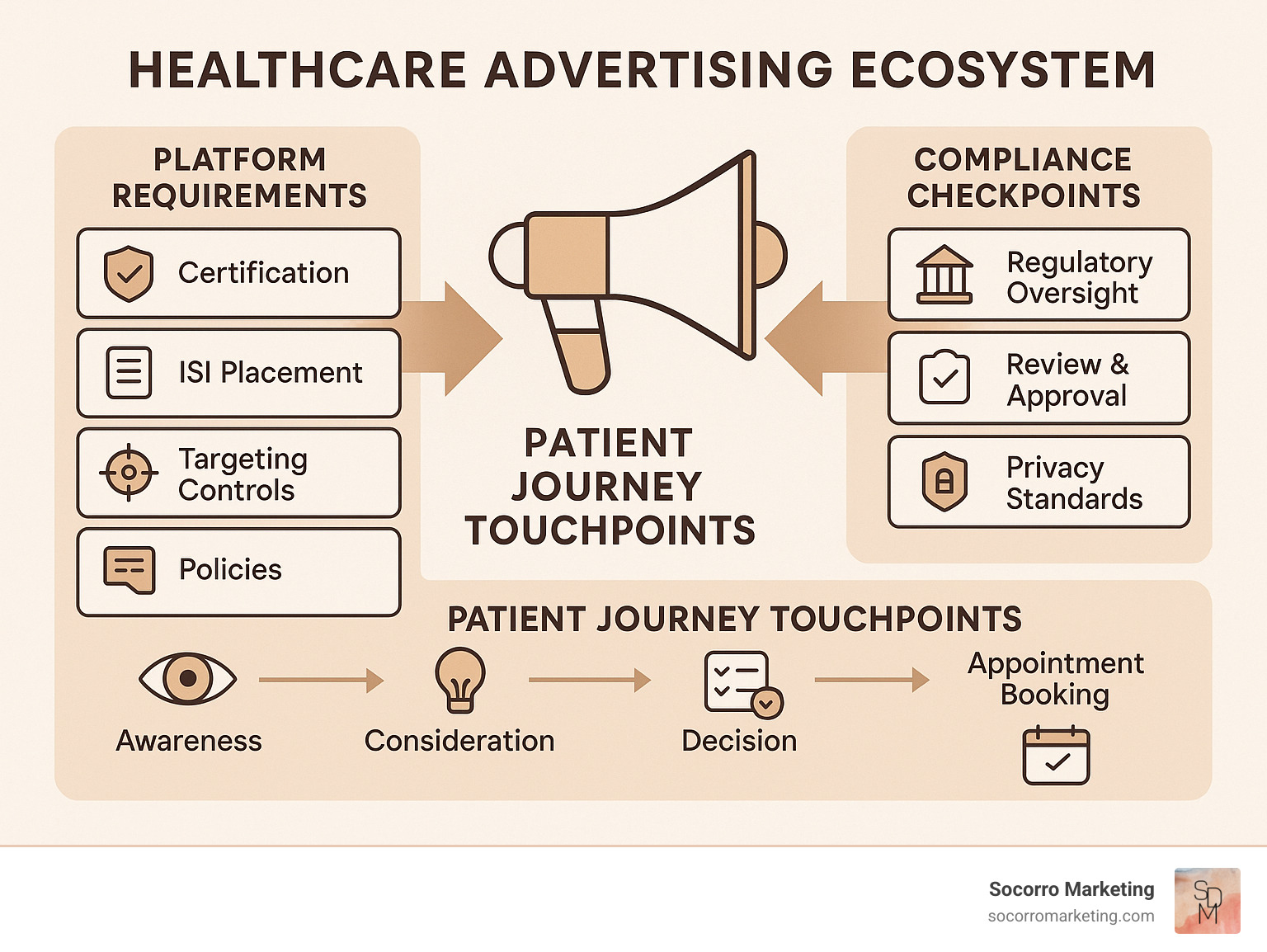
Understanding these three pillars is the first step to campaigns that grow your practice without crossing legal or ethical lines.
When you're marketing healthcare services, you're not just selling a product - you're dealing with people's lives, health, and deepest concerns. This reality creates a completely different set of rules and responsibilities that make ads for healthcare unlike any other type of advertising.
Think about it: when someone searches for "knee pain relief" at 2 AM, they're not casually shopping like they would for a new pair of shoes. They're likely dealing with real discomfort, maybe even desperation. This vulnerability means healthcare advertisers carry a special responsibility to be truthful, helpful, and ethical in every message they send.
The stakes are incredibly high in healthcare marketing. A misleading claim about a treatment's effectiveness isn't just bad advertising - it could influence someone's medical decisions in ways that affect their health and wellbeing. That's why regulators take healthcare advertising violations so seriously.
Healthcare professionals face consequences that go far beyond typical marketing penalties. Civil fines can reach tens of thousands of dollars. Disciplinary action from regulatory colleges can suspend or revoke professional licenses. Even a single complaint about misleading advertising can trigger investigations that damage a practice's reputation and livelihood.
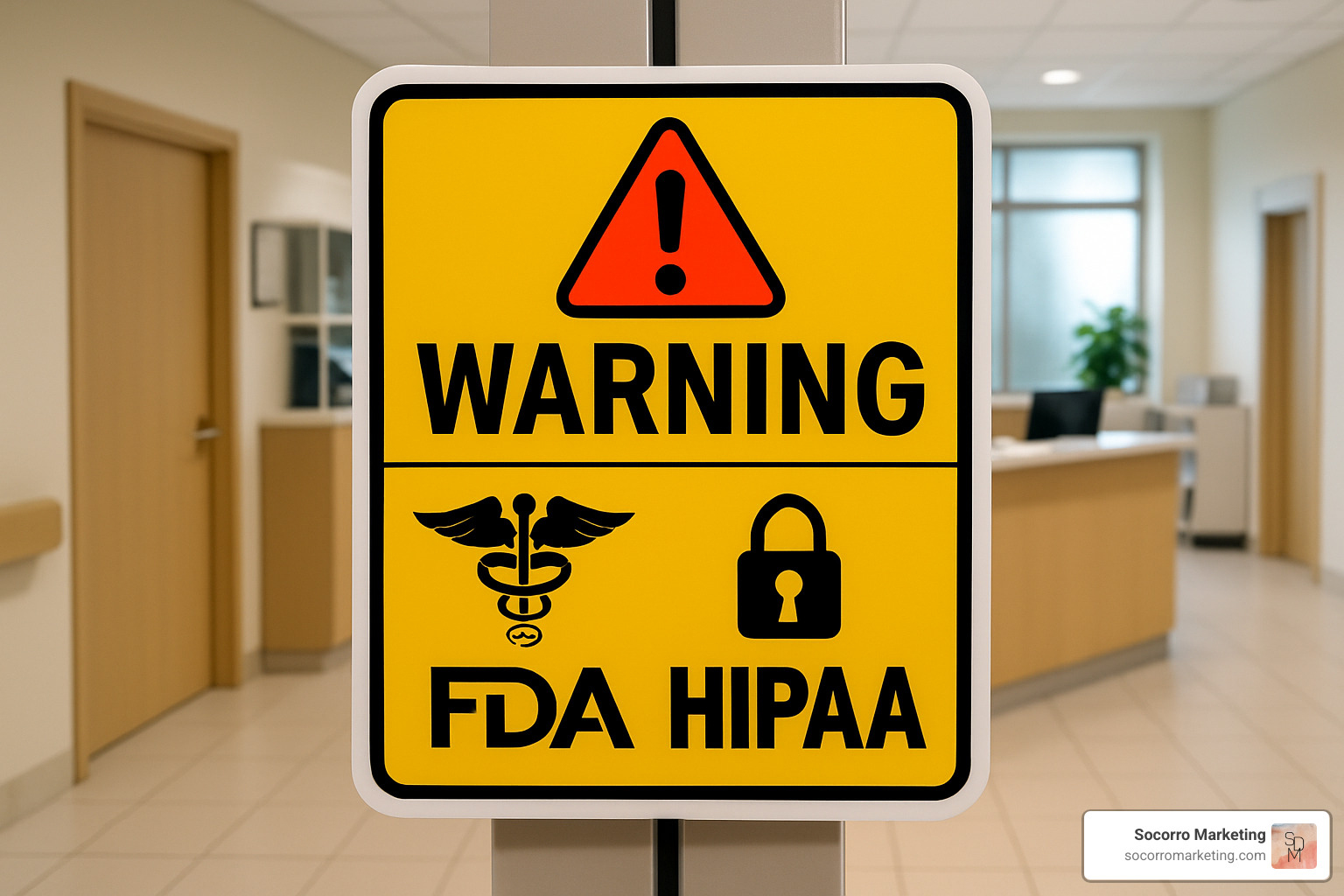
Healthcare advertising operates under multiple layers of oversight, and understanding each one is crucial for staying compliant.
Federal oversight comes from agencies like the FDA in the United States and Health Canada in our northern neighbor. These organizations have the power to issue warnings, demand corrective advertising, and pursue serious legal action for violations.
Provincial colleges add another layer of rules that healthcare professionals must follow. Each province has its own guidelines about how medical professionals can advertise their services. The consequences aren't just financial - they can affect your ability to practice medicine.
Digital platform policies create yet another set of rules to steer. Google requires healthcare provider verification before you can even run medical ads, and they prohibit targeting people based on specific medical conditions. Facebook won't let you make promises about treatment outcomes or cures.
The complexity comes from the fact that all these rules overlap and sometimes conflict with each other. Scientific research on ethical physician marketing provides valuable guidance on maintaining professional standards while still reaching patients effectively.
The line between compliant and problematic healthcare advertising often comes down to specific word choices and claims.
Superlatives are dangerous territory in healthcare advertising. Words like "best," "guaranteed," or "miracle" are red flags for regulators unless you have substantial evidence to back them up.
Outcome promises are another major no-go area. You can't guarantee that a treatment will work or promise specific results. Healthcare is too complex and individual for such certainty.
Patient testimonials might seem like great marketing, but most provincial colleges in Canada explicitly prohibit them. The concern is that personal stories can unduly influence people's medical decisions.
What you can do is focus on factual information that helps patients make informed decisions. You can share your credentials, certifications, and experience. You can explain what services you offer and provide educational information about health conditions.
| Avoid These Claims | Try These Instead |
|---|---|
| "Guaranteed results" | "Evidence-based treatment approaches" |
| "Best doctor in town" | "Board-certified specialist with 15 years experience" |
| "Cure for chronic pain" | "Comprehensive pain management services" |
| Patient testimonials | Provider credentials and education |
| "Miracle treatment" | "FDA-approved treatment options" |
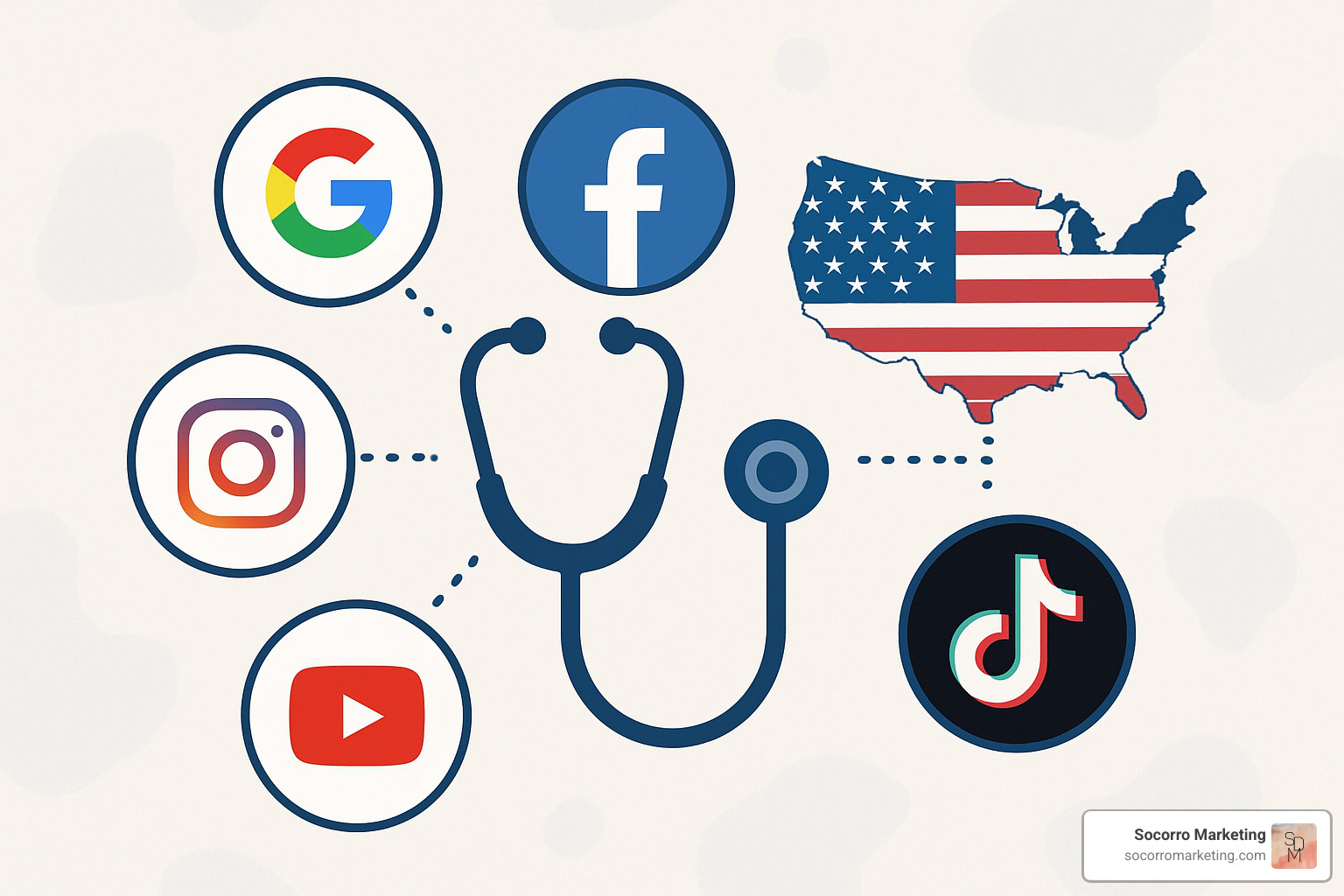
Finding the right ads for healthcare platform can feel like diagnosing a complex medical condition. You need the right tools, proper expertise, and a clear understanding of what works within healthcare's strict boundaries.
After analyzing dozens of healthcare advertising campaigns and working directly with medical practices for over 15 years, I've identified the platforms that consistently deliver results while keeping you compliant. Each solution addresses specific challenges that healthcare providers face when trying to reach patients online.
The most successful healthcare practices don't rely on just one advertising channel. Instead, they create a comprehensive approach that meets patients wherever they are in their healthcare journey.
Google Ads stands out as the most essential platform for ads for healthcare because it captures patients at the exact moment they're searching for medical help. When someone types "urgent care near me" or "dermatologist accepting new patients," Google Ads puts your practice in front of them immediately.
The verification process is your friend, not your enemy. Google requires healthcare providers to verify their credentials before running medical ads. This might seem like an extra hurdle, but it actually protects you from unqualified competitors while building patient trust through the verification badge.
Geographic targeting works perfectly for local practices. While Google restricts targeting based on medical conditions, you can still reach the right patients through location-based targeting, demographic filters, and search intent matching.
The search intent advantage cannot be overstated. Over 70% of patients start their healthcare journey with a Google search, making this platform essential for patient acquisition.
If you're finding Google Ads challenging to manage, our detailed guide on struggling with Google Ads? 4 tips to optimize your PPC campaign walks through practical optimization strategies that work specifically for healthcare practices.
Programmatic advertising is simply a way to buy ad space automatically across thousands of websites and apps. For healthcare practices, this means reaching patients while they're reading health articles, browsing medical websites, or using health-related apps.
Demand-side platforms (DSPs) built for healthcare include specialized features you won't find elsewhere. These platforms automatically place Important Safety Information where required, prevent targeting violations, and offer healthcare-specific creative formats that comply with medical advertising regulations.
The targeting capabilities are sophisticated without being invasive. You can reach people based on their general interests, geographic location, and online behavior patterns while respecting patient privacy.
Real-world results prove programmatic advertising works for healthcare. The case study on guiding the next evolution in cardiac care with programmatic advertising demonstrates how specialized healthcare DSPs drive meaningful patient engagement and measurable practice growth.
Social media advertising for healthcare requires a delicate balance between engagement and compliance. The platforms offer incredible reach and targeting capabilities, but healthcare-specific policies mean you need to approach them strategically.
Facebook's healthcare policies are strict but manageable once you understand them. You cannot use patient testimonials, make outcome promises, or target people based on health conditions. However, you can share educational content, highlight provider qualifications, and build awareness about health topics relevant to your practice.
TikTok opens unique storytelling opportunities for healthcare providers willing to accept video content. Day-in-the-life content, educational videos, and general wellness advice perform well on the platform. Just remember that TikTok requires proper certification for prescription drug promotions.
Video advertising has become essential for healthcare marketing because it allows you to explain complex medical concepts in an accessible, engaging format. Over-the-top (OTT) and connected TV advertising extend this capability to reach cord-cutting audiences with targeted, measurable campaigns.
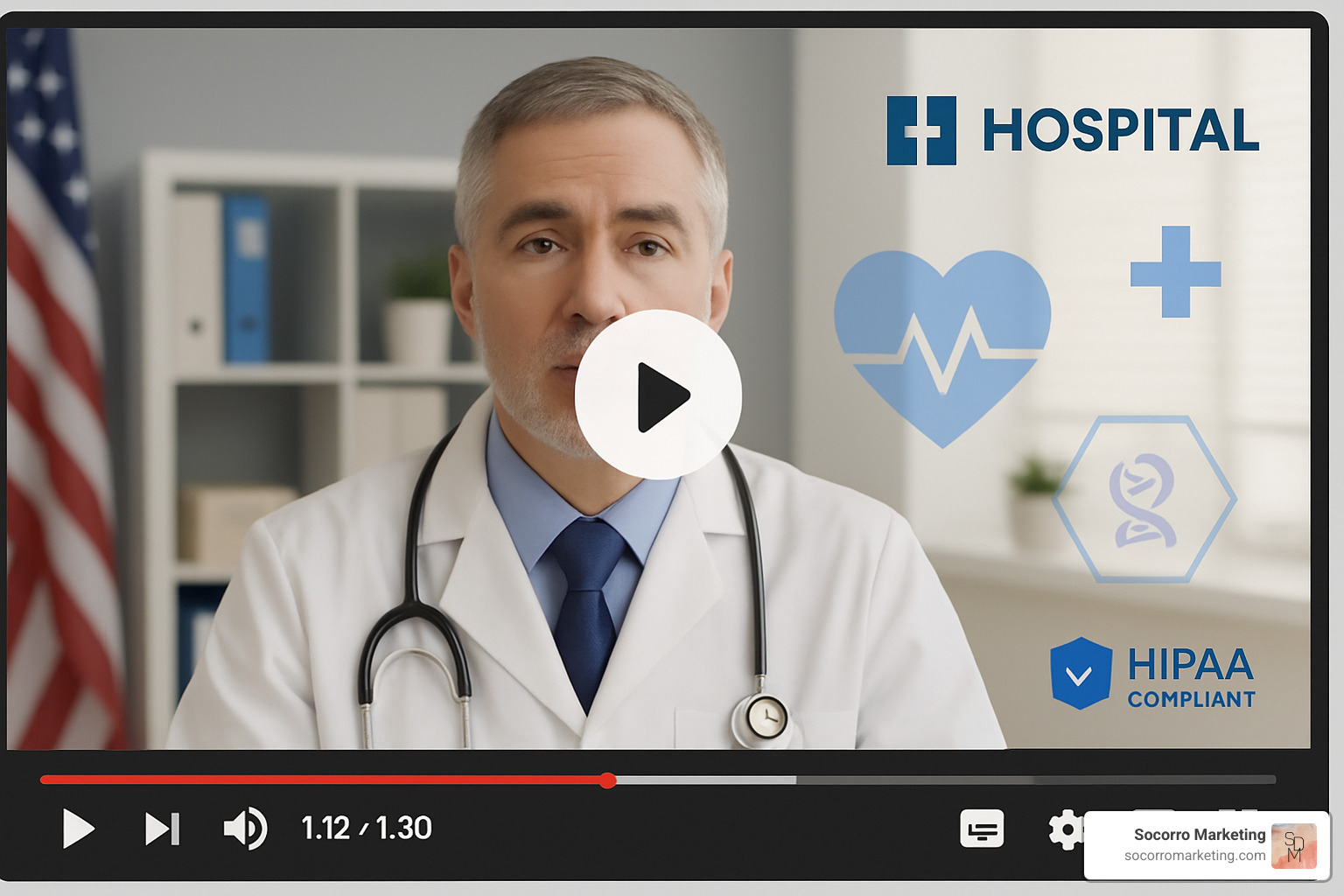
Engagement rates for video content significantly exceed static ads, making video particularly effective for healthcare advertising. When you can show rather than just tell, patients better understand your services and feel more confident choosing your practice.
Explainer videos work exceptionally well for healthcare practices. These videos help patients understand complex medical procedures, learn about prevention strategies, or know when to seek care. The key is focusing on education rather than making treatment promises.
Connected TV reaches audiences traditional advertising cannot. As more people cancel cable subscriptions, OTT advertising ensures your message reaches potential patients who no longer watch traditional television.
Healthcare advertising requires careful review before publication, and specialized tools make this process efficient while maintaining the audit trails regulators expect.
Workflow automation streamlines the approval process by automatically routing content through the right people at the right time. Your clinical staff can review medical accuracy, legal can check compliance, and marketing can approve final creative elements without manual coordination.
Audit trails are essential for regulatory compliance. Healthcare advertising review tools maintain detailed records showing who reviewed content, what changes were made, and when final approval was granted.
Tools like Filestage offer healthcare practices a seven-day free trial to test workflow automation and compliance features before committing to a full implementation.
Think of this as your final health check before your ads for healthcare go live. Just like you wouldn't discharge a patient without reviewing their chart one more time, launching healthcare advertising without a thorough compliance review is asking for trouble.
The reality is that healthcare advertising violations can result in serious consequences - from platform bans to regulatory fines to damage to your professional reputation. But here's the good news: most violations are completely preventable with a systematic pre-launch review.
Every single claim in your healthcare advertising needs to be objectively true and backed by solid evidence. This isn't just good practice - it's a legal requirement. When you say your practice has "15 years of experience," that needs to be verifiable. When you mention treatment options, they should align with current medical standards.
Evidence-based content forms the foundation of compliant healthcare advertising. Your claims should reference credible sources like peer-reviewed research, professional medical associations, or official health organization guidelines.
Patient testimonials are explicitly prohibited by most provincial colleges in Canada. Even in jurisdictions where they're technically allowed, testimonials create liability issues and can imply guaranteed outcomes. It's simply safer to focus on your credentials, experience, and approach to care.
Visual content requires special attention too. Before-and-after photos, patient images, and even stock photos of medical procedures must comply with privacy laws and platform policies. Any content that could identify a patient needs explicit written consent.
Understanding Canadian healthcare advertising laws is crucial for practices operating in Canada. The regulations are detailed and specific, covering everything from allowable claims to required disclaimers.
For healthcare practices working to develop messaging that's both compelling and compliant, our guide on defining your message and brand with medical content marketing offers practical frameworks for creating content that builds trust while staying within regulatory boundaries.
Patient privacy isn't just a nice-to-have in healthcare advertising - it's the law. And the rules are stricter than many healthcare providers realize.
De-identification is non-negotiable when using any patient information in your advertising. HIPAA has specific requirements for removing both direct identifiers and indirect identifiers that could be used to figure out who someone is.
Getting consent sounds straightforward, but it's complicated in healthcare advertising. Yes, you need explicit written consent to use patient stories, images, or information. But even with proper consent, many regulatory bodies still prohibit or heavily restrict testimonials.
Retargeting gets tricky fast in healthcare. Targeting people who visited your "diabetes treatment" page or searched for "anxiety medication" can create HIPAA compliance issues. You need to be extremely careful about how you set up retargeting campaigns.
Your landing pages must be bulletproof from a security standpoint. This means proper encryption, secure form handling, and HIPAA-compliant data storage.
The most successful healthcare practices don't leave compliance to chance - they build it into their processes from day one.
Comprehensive checklists are your safety net. Create detailed checklists covering federal regulations, provincial or state requirements, platform policies, and your own internal standards. These checklists need regular updates as regulations and policies change.
Legal review doesn't have to slow you down if you plan for it. Establish clear protocols upfront: who needs to review what, how long each review takes, and what happens if there are questions or concerns.
Version history management is essential for regulatory compliance. You need detailed records of all content versions, who made changes, and when approvals were granted. This documentation becomes critical if you ever face a regulatory inquiry.
Regular audits of your active campaigns help catch issues before they become problems. Set up quarterly reviews of all active healthcare advertising to ensure continued compliance.
Creating effective ads for healthcare is like writing a prescription - you need the right ingredients, proper dosage, and careful monitoring to get the desired results. The best healthcare advertising combines compelling storytelling with precise performance tracking while staying within compliance boundaries.
Healthcare advertising creative faces unique challenges. You can't make bold promises or use patient testimonials like other industries. Instead, you need to build trust through education and empathy while still driving conversions.
Patient-centric storytelling forms the foundation of successful healthcare advertising. Instead of leading with your credentials or technology, start with what patients actually worry about. Are they afraid of pain? Confused about treatment options? Worried about costs? Address these concerns directly.
Generational targeting makes a huge difference in healthcare advertising performance. Millennials want convenient, tech-enabled experiences and respond well to mobile-first campaigns. Generation X values clear information and straightforward paths to care. Baby Boomers prefer detailed educational content and traditional communication methods like phone calls.
Mobile-first design isn't optional anymore - it's essential. Over 60% of healthcare searches happen on mobile devices. Your ads and landing pages must load fast, look great on small screens, and make it easy to take action with one thumb.
For practices specializing in mental health services, our guide on behavioral health digital marketing provides specific strategies for this sensitive area of healthcare advertising.
The best healthcare advertising tells stories that help patients while driving business results. This balance requires skill, empathy, and a deep understanding of what patients actually need.
Empathy-driven messaging acknowledges real patient concerns without exploiting fear. Instead of saying "Don't let back pain ruin your life," try "Back pain shouldn't keep you from the activities you love." The difference is subtle but important - one creates anxiety, the other offers hope.
Education-focused content builds trust by giving patients useful information. Explain when someone should see a specialist, what to expect during treatment, or how to prepare for procedures. This approach positions you as a helpful expert rather than just another advertiser.
Prevention messaging often works better than treatment-focused ads because it's less threatening and more broadly applicable. Content about staying healthy, preventing injuries, or maintaining wellness resonates with larger audiences while avoiding sensitive medical topics.
Healthcare advertising measurement requires tracking metrics that reflect both immediate campaign performance and long-term patient relationships.
Cost per acquisition (CPA) in healthcare should include the full cost of acquiring a new patient, not just getting a lead. A $50 cost per form submission might seem great until you realize only 10% of those leads become patients. The real CPA is $500, which changes your optimization strategy completely.
Patient lifetime value (LTV) provides the most accurate picture of healthcare advertising ROI. A patient who comes for an annual checkup might generate $200 in immediate revenue but $2,000 over five years. Understanding LTV helps justify higher acquisition costs and longer sales cycles.
Attribution modeling gets complex in healthcare because patients research extensively before making decisions. Someone might see your Facebook ad, search for your practice on Google, read reviews, and call three weeks later. Multi-touch attribution helps you understand which channels actually drive patients.
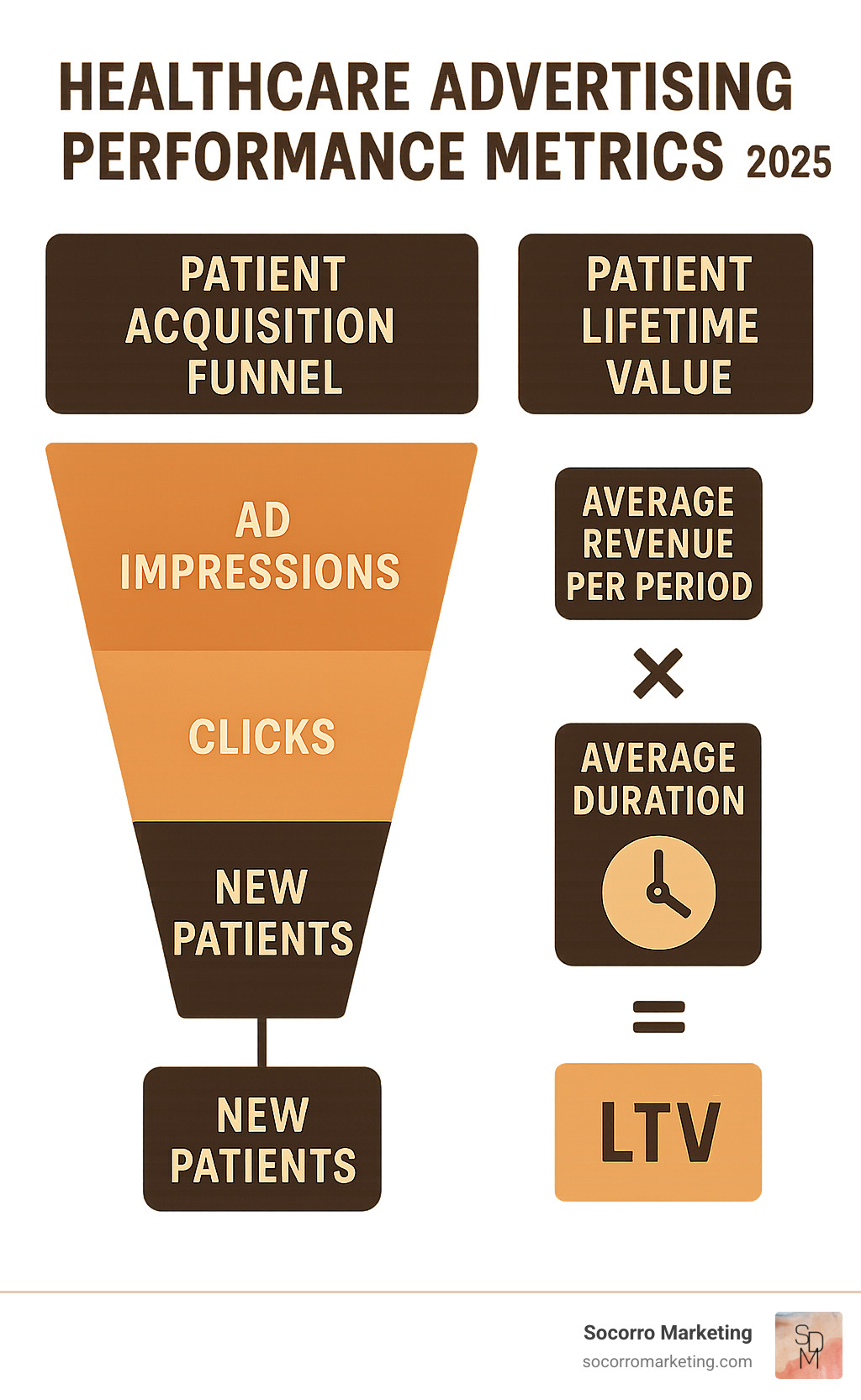
The most successful healthcare practices track both leading indicators (ad clicks, form submissions, phone calls) and lagging indicators (new patients, revenue, patient satisfaction). This comprehensive view helps you optimize campaigns for real business results, not just marketing metrics.
Healthcare advertising brings up lots of questions - and for good reason. The rules are complex, the stakes are high, and one wrong move can shut down your entire campaign. Let me walk you through the most common concerns I hear from healthcare providers.
This is probably the question I get asked most often, and I totally understand the frustration. Patient testimonials seem like they'd be perfect for healthcare marketing - after all, what's more powerful than a real patient sharing their positive experience?
The reality is that testimonials create a minefield of compliance issues. Most provincial colleges in Canada flat-out prohibit them, and there are solid reasons why.
The main problem is misleading expectations. When patients see someone else's success story, they naturally assume they'll get similar results. But healthcare doesn't work that way - every patient is different, and outcomes vary significantly based on individual circumstances.
Privacy concerns add another layer of complexity. Even with patient consent, using their health information in advertising can violate HIPAA or other privacy laws. The legal risks often outweigh any marketing benefits.
Platform policies make things even trickier. Google, Facebook, and other advertising platforms have their own restrictions on healthcare testimonials. Your ad might be compliant with medical regulations but still get rejected by the platform.
Instead of testimonials, focus on what you can control - your credentials, your approach to patient care, and educational content that helps people make informed decisions.
This question comes up constantly, and it's a legitimate concern. You need to reach patients in your area, but you can't violate their privacy in the process. The good news is that effective local targeting and HIPAA compliance can absolutely work together.
Geographic targeting is your best friend. You can target people within a certain radius of your practice without knowing anything about their health status. This approach reaches potential patients in your service area while keeping their medical information private.
Demographic targeting works well too. You can target by age, gender, or general interests without crossing into health-specific territory. For example, targeting women aged 25-45 for OB/GYN services is perfectly compliant.
The key is avoiding condition-specific targeting. Don't target people based on their medical searches, health-related page visits, or suspected medical conditions. This crosses the line into potentially identifying health information.
Nobody wants to think about this scenario, but it's important to understand the consequences. Platform violations can range from minor inconveniences to major business disruptions, depending on what went wrong.
Most violations start small. Your ad gets disapproved, you get a notification explaining the issue, and you can revise and resubmit. This happens to almost everyone at some point - platform policies are complex and constantly changing.
Repeated violations escalate quickly. If you keep making the same mistakes, platforms may restrict your account or require additional review for all future ads. This slows down your marketing and makes everything more complicated.
Serious violations can shut you down completely. Account suspension means all your ads stop running immediately. For healthcare practices that depend on digital marketing, this can be devastating.
Prevention is worth everything. Set up thorough internal review processes before launching any ads for healthcare. Stay updated on policy changes - what was allowed last month might be prohibited today.
Creating successful ads for healthcare isn't just about following rules - it's about building genuine trust with patients while growing your practice responsibly. The healthcare advertising landscape may seem overwhelming at first, but the rewards for getting it right are tremendous.
At Socorro Marketing, we understand this challenge from both sides of the stethoscope. Our nurse-managed approach brings real clinical insight to healthcare advertising, something you won't find at typical marketing agencies. Based in Golden, CO, we've helped healthcare practices across Colorado, Utah, Arizona, and New Mexico steer this complex landscape successfully.
What makes our approach different? We actually understand the medical side of your practice. We know why certain claims can't be made, which targeting strategies protect patient privacy, and how to create campaigns that educate rather than exploit. This clinical background allows us to spot compliance issues before they become problems.
The healthcare advertising opportunities are enormous right now. With healthcare digital advertising spending reaching $13.82 billion in 2023 and over 70% of patients starting their healthcare journey online, the potential for growth is clear. But only for practices that approach it correctly.
Your path to compliant healthcare advertising success starts with understanding that compliance and effectiveness aren't opposing forces - they work together. When you prioritize patient education over flashy promises, use platform-specific healthcare features, and focus on building long-term patient relationships, you create advertising that both regulators and patients appreciate.
The landscape will keep evolving. New platforms will emerge, regulations will change, and patient expectations will shift. Success means staying informed while maintaining that fundamental commitment to ethical, patient-centered marketing.
Ready to grow your practice through advertising that actually works? We're here to help you steer every aspect of healthcare advertising, from initial strategy through ongoing optimization. Our combination of clinical expertise and marketing certification gives you the specialized knowledge needed to succeed in this unique industry.
For healthcare practices looking to complement their paid advertising efforts, our comprehensive guide on best SEO strategy for increasing the traffic of the website shows how organic growth strategies work hand-in-hand with ads for healthcare to build sustainable practice growth.
The future of healthcare advertising belongs to practices that understand both the medical and marketing sides of patient care. Let's build that future together.